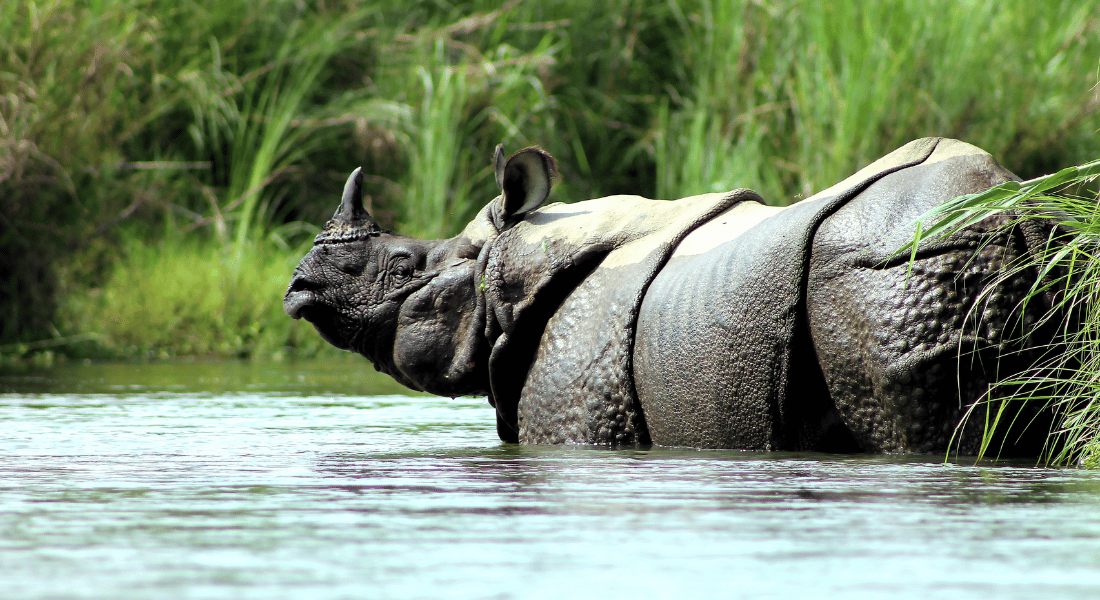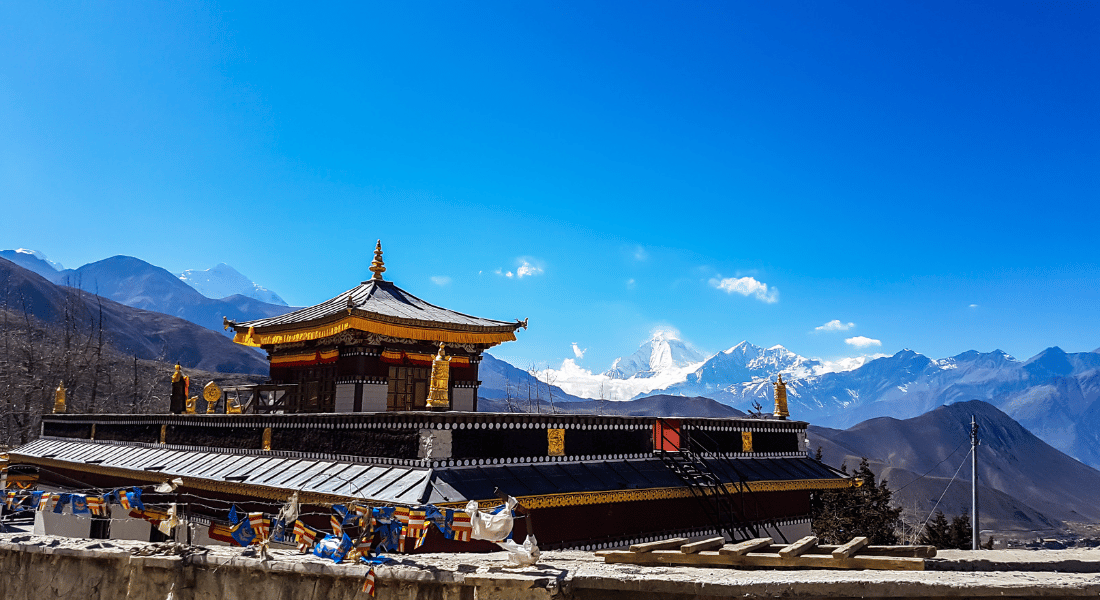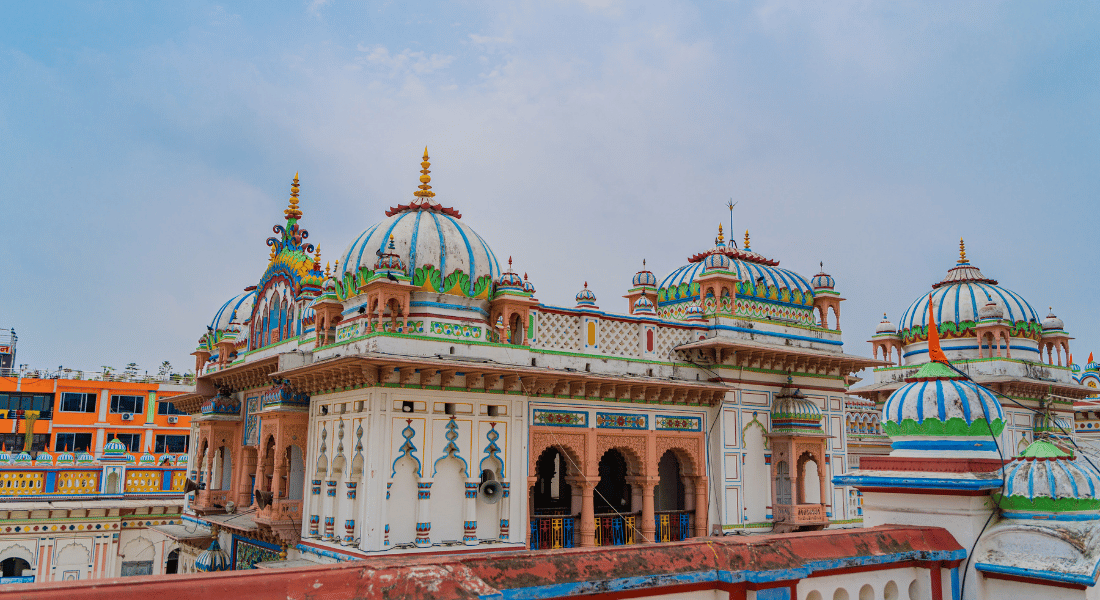Nepal is a land of unparalleled beauty and diversity, offering a captivating blend of nature, adventure, culture, and spirituality. For travellers seeking an immersive experience, Nepal presents a myriad of opportunities to explore its stunning landscapes, rich cultural heritage, and thrilling adventure activities. Our blog Top 5 places to visit in Nepal aims to provide you with an insightful and engaging guide to some of Nepal's most captivating destinations, so that you can plan a trip that will be both memorable and won't miss out on the must-visits. It is an essential resource for anyone considering a trip to Nepal, providing a well-rounded perspective on the country's most treasured spots.
Through detailed descriptions, and practical travel tips it hopes to bring these locations to life and inspire you to explore Nepal's incredible landscapes and cultures. As you read through this blog, you'll find a curated selection of destinations that highlight the diverse experiences awaiting you in this enchanting country. The 5 destinations included such as Kathmandu, Pokhara, Chitwan, Muktinath and Janakpur provide a comprehensive glimpse into its multifaceted appeal. From an altitude as high as 3710m to altitude as low as 74m the top destinations included in this blog provides you with an all rounded experience of the diverse country, Nepal.
This blog will guide you through the top five must-visit places in Nepal, each offering its own distinct charm and allure. From the bustling streets of Kathmandu to the tranquil lakes of Pokhara, the sacred grounds of Jankpur to the wild jungles of Chitwan, and the majestic trails of the Annapurna region, these destinations capture the essence of what makes Nepal so special. Scroll further to discover why Nepal should be at the top of your travel list.
Why is Nepal a Must-Visit for Indian Tourists?
Nepal, a neighbour to India, stands as an enticing destination for Indian tourists due to its geographical and ease of access. The two countries share an open border, which means Indian citizens can travel to Nepal without the need for a visa, making it incredibly convenient. Additionally, multiple direct flights and well-connected roadways enhance accessibility, allowing for a seamless travel experience. This close geographical relationship not only reduces travel time and costs but also provides an opportunity for spontaneous trips and weekend getaways, making Nepal an attractive option for Indian travellers.
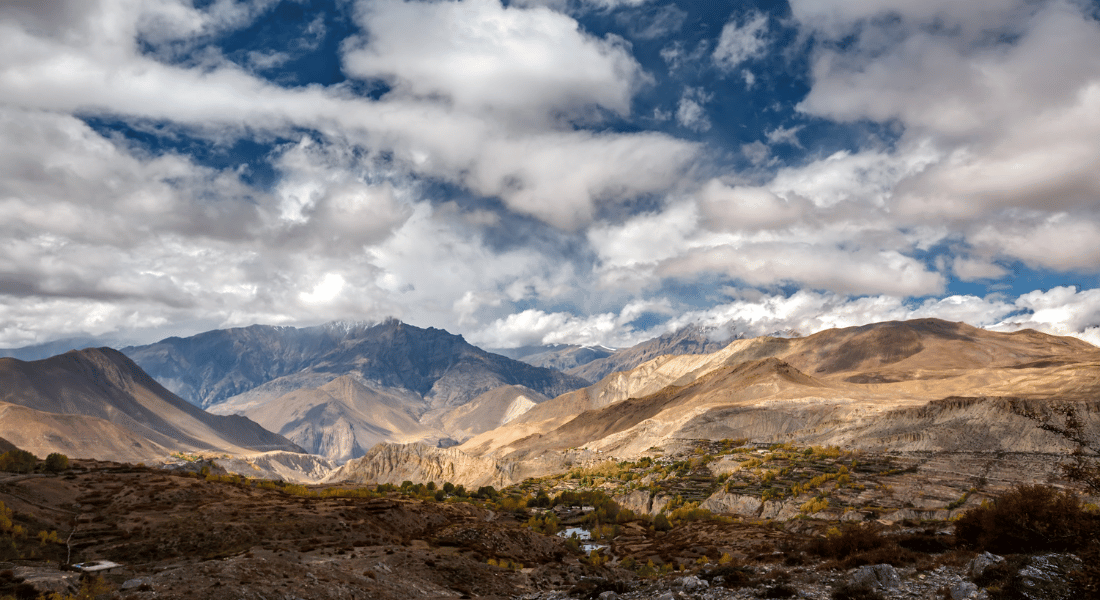
Cultural and religious connections further cement Nepal's appeal to Indian tourists. Nepal is the birthplace of Lord Buddha, attracting many Indians to the sacred site of Lumbini. Moreover, the country's rich tapestry of Hindu culture, with temples and rituals similar to those in India, offers a familiar yet distinct experience. Pashupatinath Temple in Kathmandu, a significant pilgrimage site dedicated to Lord Shiva, draws thousands of Indian devotees annually. The shared festivals, traditions, and languages foster a sense of kinship and make Indian visitors feel at home while exploring Nepal's unique cultural background.
Beyond the convenience and cultural connections, Nepal offers some of the most stunning landscapes in the world. The majestic Mount Everest, the serene lakes of Pokhara, and the lush jungles of Chitwan National Park provide a range of experiences for nature lovers and adventure enthusiasts alike. For Indian travelers, many of whom reside in bustling urban centers, the chance to immerse themselves in Nepal’s tranquil and unspoiled environments is a refreshing escape. The combination of convenience, shared cultural and religious values, the rich natural allure of Nepal makes it an irresistible destination for Indian travelers seeking both relaxation and excitement.
List of top 5 places to visit in Nepal
Here is the list of top five places to visit in Nepal that promise a blend of natural beauty, cultural richness, and spiritual significance.
|
Destination |
Major Sites |
|
Kathmandu Valley |
|
|
Pokhara |
|
|
Chitwan |
|
|
Muktinath |
|
|
Janakpur |
|
Nepal, a land of dramatic landscapes and rich cultural tapestry, offers an extraordinary experience for travellers seeking adventure, spiritual enlightenment, and a deep dive into history. With the towering Himalayas as its backdrop, this small yet diverse country is home to some of the world's most iconic destinations.
Kathmandu Valley
Kathmandu Valley, nestled in the heart of Nepal, is a cultural and historical gem renowned for its rich heritage and stunning surrounding hills. The valley encompasses the capital city, Kathmandu along with the ancient towns Bhaktapur and Patan. Kathmandu boasts iconic landmarks such as Swaymabhunath, Pashupatinath and the historic Durbar Square. Patan, located in Lalitpur, is renowned for its exquisite craftsmanship and artistry particularly in metal work and stone carving. The Patan Durbar Square with its stunning temples and palaces, reflects the rich cultural heritage of the Newar community. Similarly, Bhaktapur is famous for its mediaeval charm, featuring narrow streets, ancient pagoda-style temple and the iconic Bhaktapur Durbar Square. Together, these three cities in Kathmandu valley encapsulate the rich history and vibrant culture of Nepal.
Cultural and Historical Site
Kathmandu is a treasure trove of cultural and historical landmarks. The city's centrepiece, Kathmandu Durbar Square, is a UNESCO World Heritage Site brimming with palaces, courtyards, and temples, including the Hanuman Dhoka Palace and the intricately carved Taleju Temple. Nearby, the ancient city of Patan boasts its own Durbar Square, renowned for the exquisite Krishna Temple and the Golden Temple (Hiranya Varna Mahavihar). Bhaktapur, another historic city in the Kathmandu Valley, is famous for its well-preserved mediaeval architecture of Bhaktapur Durbar Square, including the stunning Nyatapola Temple. These sites, alongside countless other historical monuments, showcase the artistry and craftsmanship of the Newar people and serve as a testament to Kathmandu's enduring cultural legacy.
Religious Site
Kathmandu boasts a vibrant mix of Hinduism and Buddhism where grand hindu temples share space with Buddhist stupas, creating a remarkable atmosphere of tolerance and interfaith harmony. The city is home to the sacred Pashupatinath Temple, one of the holiest Hindu temples dedicated to Lord Shiva, attracting thousands of pilgrims annually. Equally significant is the Swayambhunath Stupa, also known as the Monkey Temple, a revered Buddhist pilgrimage site offering panoramic views of the city. The Boudhanath Stupa, one of the largest spherical stupas in Nepal, stands as a central hub for Tibetan Buddhism. These sites, along with numerous other temples, monasteries, and shrines, make Kathmandu a vibrant centre for religious devotion and cultural convergence, drawing visitors from around the world to experience its unique spiritual ambiance.
|
Key Highlights of Kathmandu |
|
Rich blend of Hindu and Buddhist traditions. |
|
Vibrant street life and bustling markets. |
|
Traditional Newari architecture. |
|
Cultural festivals such as Indra Jatra and Dashain. |
Related Read: Kathmandu Sightseeing
Pokhara- Adventure Capital
Pokhara, nestled beside Phewa Lake and against the backdrop of the Annapurna Range, is a serene city renowned for its natural beauty and adventure activities. Boating on the lake, visiting the Peace Pagoda for panoramic views, and visiting nearby viewpoints like Sarangkot are popular activities. Pokhara also serves as a gateway to treks in the Annapurna region, offering a laid-back atmosphere with lakeside cafes and shops.

Adventure and Natural Sites
Pokhara, a stunning city in Nepal, is a haven for adventure enthusiasts and nature lovers alike, offering a plethora of outdoor activities amidst breathtaking natural landscapes. First and foremost, the city itself serves as a gateway for the world's renowned trekking routes to Annapurna. The serene Phewa Lake, with the reflection of the majestic Machapuchare (Fishtail) Mountain, provides opportunities for boating and lakeside relaxation. For thrill-seekers, Sarangkot in Pokhara offers adventure experiences such as paragliding, ultralight flight and zipline with panoramic views of the Himalayas and the city below, while the Seti River gorge and Devi's Falls showcase nature's raw beauty. The World Peace Pagoda, perched on a hilltop, offers a tranquil spot with sweeping views of the valley. These natural and adventurous sites make Pokhara a must-visit destination for those seeking both tranquillity and excitement in a picturesque setting.
Religious Sites
Pokhara, while renowned for its natural beauty, also serves the tourists with its significant religious sites. The Tal Barahi Temple, located on a small island in Phewa Lake, is one of the most important Hindu shrines in the region, dedicated to the goddess Barahi. The Bindhyabasini Temple, perched on a hilltop, is another revered Hindu site, offering stunning views of the Himalayas and the city. For Buddhist devotees, the World Peace Pagoda, also known as Shanti Stupa, stands as a symbol of peace and offers a serene environment for meditation, along with panoramic vistas of the Annapurna range. Additionally, the nearby Gupteshwor Mahadev Cave housing a sacred Shiva Lingam is also a notable religious landmark. These sites collectively highlight the spiritual diversity of Pokhara.
|
Key Highlights of Pokhara |
|
Stunning natural beauty with lakes, mountains, and caves. |
|
Vibrant Nightlife. |
|
Thrilling adventure activities like paragliding and trekking. |
|
Gateway to the Annapurna trekking regions. |
|
Various religious temples. |
Chitwan National Park
As Nepal's first national park and a UNESCO World Heritage Site, Chitwan National Park spans over 952 square km of lush forests, grasslands, and wetlands. Located in the subtropical Terai lowlands, it offers opportunities to spot rare species like Bengal tigers, one-horned rhinos, and elephants during jungle safaris. Visitors can also experience Tharu culture, enjoy canoe rides on the Rapti River, and participate in elephant bathing activities.
Wildlife and Natural Site
The park is renowned for its rich biodiversity, including Bengal tigers, one-horned rhinoceroses, elephants, and various bird species. The park's lush jungles, grasslands, and rivers offer a great escape into nature and provide opportunities for wildlife viewing and photography. Visitors can explore the park through guided jungle safaris, either on elephant back or in jeeps, allowing for close encounters with the wildlife. The park also provides a habitat for numerous reptiles and amphibians, making it a crucial sanctuary for wildlife conservation.
Adventure Site
Chitwan National Park, primarily celebrated for its wildlife and natural beauty, also offers thrilling adventure experiences that attract outdoor enthusiasts. The area is popular for jungle safaris, which provide thrilling opportunities to observe wildlife up close. Canoeing on the Rapti River offers a chance to see crocodiles and bird species. Also, the gentle flow of the river allows for a peaceful ride while spotting various aquatic animals. For those seeking a more immersive experience, guided jungle walks provide an adrenaline-pumping way to explore the dense forest and its inhabitants on foot. Additionally, the park’s adventure offerings include bird-watching, cycling through the scenic countryside, and cultural excursions to local Tharu villages, blending adventure with cultural enrichment in a stunning natural setting.
|
Key Highlights of Chitwan National Park |
|
Rich biodiversity and close wildlife encounters. |
|
Unique Tharu culture and traditional village tours. |
|
Soothing adventure activities. |
|
Bird-watching tours. |
|
Ecotourism and conservation education. |
Learn More: Chitwan National Park
Muktinath
Muktinath, located at an altitude of 3,710 metres in the Mustang district, holds great religious significance for both Hindus and Buddhists. The sacred site features a temple with 108 water spouts and eternal flames, surrounded by breathtaking Himalayan views. Pilgrims visit to cleanse themselves in the holy waters and receive blessings, while trekkers often include Muktinath on the Annapurna Circuit trek.
Religious Sites
Muktinath, situated in the Mustang district of Nepal, is a revered pilgrimage site for both Hindus and Buddhists, nestled at an altitude of 3,710 meters in the Himalayas. For Hindus, Muktinath Temple is dedicated to Lord Vishnu and is considered one of the 108 Divya Desams, sacred abodes of Vishnu. The temple complex includes 108 water spouts, known as Mukti Dhara, from which holy water pours, believed to purify and liberate souls from sin. Buddhists revere Muktinath as Chumig Gyatsa, meaning "Hundred Waters," and consider it a place where the great sage Guru Rinpoche, also known as Padmasambhava, meditated. Moreover, it holds deep spiritual significance, and many pilgrims undertake the journey to Muktinath to seek blessings and purification. The unique convergence of these two major religions at Muktinath, makes it a spiritually significant place.
Nature Sites
This sacred Muktinath temple goes beyond the religious significance. Surrounded by the dramatic landscape of the Annapurna and Dhaulagiri mountain ranges, Muktinath offers breathtaking panoramic views of snow-capped peaks and deep valleys. The area is characterised by its unique blend of arid, rocky terrain and lush greenery, creating a stark yet beautiful contrast. The Kali Gandaki River, which flows nearby, is renowned for its natural fossils called Shaligrams, considered sacred in Hinduism. The pristine environment, combined with the spiritual ambiance, makes Muktinath a captivating destination for nature lovers and pilgrims alike, offering a serene and awe-inspiring retreat in the lap of the Himalayas.
|
Key Highlights of Muktinath |
|
Spiritual pilgrimage site with significant religious importance. |
|
Awe-inspiring Himalayan landscapes. |
|
Trekking routes like the Annapurna Circuit pass through here. |
|
Scenic road towards the destination. |
|
Pleasant mountain air. |
Learn More: Muktinath Temple
Janakpur - City of Ponds
It is revered as the birthplace of Goddess Sita, the consort of Lord Rama, and the setting for their marriage, making it a major pilgrimage site. The city is known for the Janaki Mandir, a grand temple dedicated to Goddess Sita, with its impressive architecture and religious significance drawing devotees from across Nepal and India. Janakpur offers a glimpse into traditional Maithili culture, with vibrant festivals and rituals enriching the visitor experience.
Religious Sites
Janakpur is a significant pilgrimage site for Hindus. The Janaki Mandir, dedicated to Sita, is a stunning example of Mughal and Rajput architecture. The temple is a major attraction and draws devotees from all over the world. The city is also famous for the Vivah Mandap, the place where Sita and Rama were married, making it an important site for religious ceremonies and festivals. The annual Vivah Panchami festival, celebrating the divine marriage, attracts thousands of pilgrims and is marked by grand celebrations. Other important religious landmarks include the Ram Mandir and the numerous sacred ponds, such as Ganga Sagar and Dhanush Sagar, which are integral to various rituals and ceremonies. Janakpur's vibrant religious heritage and its association with the epic Ramayana make it a revered pilgrimage destination for Hindus, offering a profound spiritual experience amidst its historical and cultural richness.
Cultural Sites
The Jankpur city itself is a city carrying rich Maithili culture. The city hosts the vibrant Vivah Panchami festival, which reenacts the wedding of Sita and Rama and attracts thousands of pilgrims and tourists. Janakpur is also famous for its Mithila paintings, a traditional art form characterized by intricate designs and vivid colors, often depicting religious themes and everyday life. The local markets and museums showcase these artworks, along with traditional Maithili music and dance, preserving and promoting the region's cultural heritage. This blend of religious devotion, artistic expression, and historical significance makes Janakpur a vital cultural hub in Nepal.
|
Key Highlights of Janakpur |
|
Historical significance as the birthplace of Sita. |
|
Architectural beauty of Janaki Mandir. |
|
Deep-rooted Maithili culture and traditions. |
|
Vibrant festivals and religious events. |
|
Cultural immersion in local art and handicrafts. |
Learn More: Janakpur Nepal
Beyond the Top 5
Beyond Nepal's well-known top five destinations lies a treasure trove of lesser-explored yet captivating places waiting to be discovered. These destinations not only promise unique cultural experiences and natural beauty but also provide a quieter, more intimate exploration of Nepal's diverse landscapes and rich heritage beyond the crowded areas.
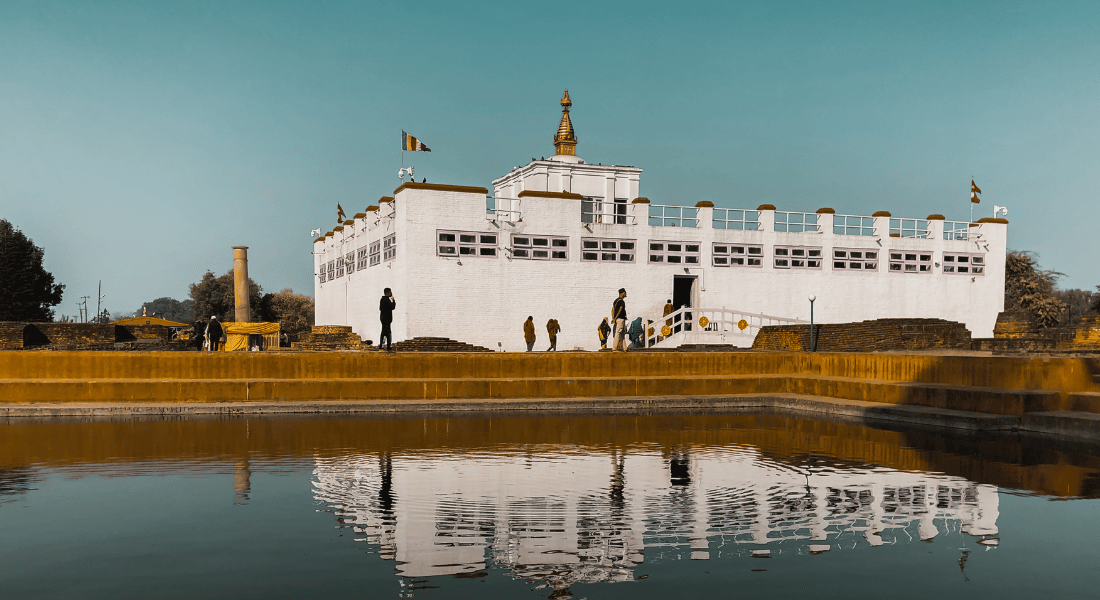
Here’s the list of it:
Lumbini - Birthplace of Gautam Buddha
Lumbini, located in the Rupandehi district of Nepal, holds immense significance as the birthplace of Siddhartha Gautama, the historical Buddha. The centrepiece of Lumbini is the Maya Devi Temple, built on the spot where Maya Devi is believed to have given birth to Prince Siddhartha under a sal tree. Visitors can also explore the sacred Lumbini Garden, which encompasses ancient ruins and monuments, including the Ashoka Pillar erected by Emperor Ashoka in the 3rd century BCE. Beyond its religious significance, Lumbini offers a peaceful ambiance for contemplation and reflection amidst tranquil gardens and ponds.
Learn More: Lumbini Nepal
Ghandruk - Gurung Village
Ghandruk is a picturesque village located in the Kaski District of Nepal, within the Annapurna Conservation Area. It is renowned for its stunning mountain views, rich Gurung culture, and as a popular trekking stop in the Annapurna region. Visitors to Ghandruk have the opportunity to experience Gurung hospitality firsthand, with homestay accommodations offering a glimpse into local customs, cuisine, and daily life. The village is characterised by traditional Gurung architecture, featuring stone houses with slate roofs and intricately carved wooden windows and doors. In addition to its cultural significance, it provides stunning natural vistas as it is situated at an altitude of 2012m. It offers breathtaking views of some of the highest peaks in the Annapurna range, including Annapurna South, Machhapuchhre (Fishtail), and Hiunchuli.
Bandipur - Classic Newari Town
Bandipur is a charming hilltop town located in the Tanahun district of Nepal, about 146 KM west of Kathmandu and 77 km east of Pokhara. It is renowned for its well-preserved Newari architecture, stunning views of the Himalayas, and its peaceful atmosphere. The town is lined with beautifully preserved Newari houses, adorned with intricately carved windows, wooden facades, and traditional brickwork. The Khadga Devi Temple, Mahalaxmi Temple, and Bindyabasini Temple are among the notable religious sites of this village. Surrounding Bandipur are trails that lead through lush forests and pristine landscape. Also, the sunrise and sunset view from the hill top is particularly beautiful with panoramic views of the Himalayas including Dhaulagiri, Annapurna, Manaslu and so on.
Nagarkot Hillstation
Nagarkot, nestled in the Bhaktapur district of Nepal, is renowned for offering some of the most spectacular sunrise views over the Himalayas, including the towering peaks of Mount Everest on clear days. Located approximately 32 kilometres east of Kathmandu, this hilltop retreat sits at an altitude of about 2,195 metres (7,201 feet), providing panoramic vistas that attract both locals and tourists alike. Beyond its renowned sunrise views, Nagarkot offers a peaceful escape from the bustling city life of Kathmandu, with opportunities for hiking, mountain biking, and exploring nearby villages. The area is dotted with resorts and guest houses offering comfortable accommodations, making it a popular destination for overnight stays.
Related Read: Hill stations in Nepal
Best time to visit Nepal from India
The best time to visit Nepal from India largely depends on the type of experience you're seeking, whether it's trekking, cultural exploration, or wildlife viewing. Generally, Nepal experiences four distinct seasons:
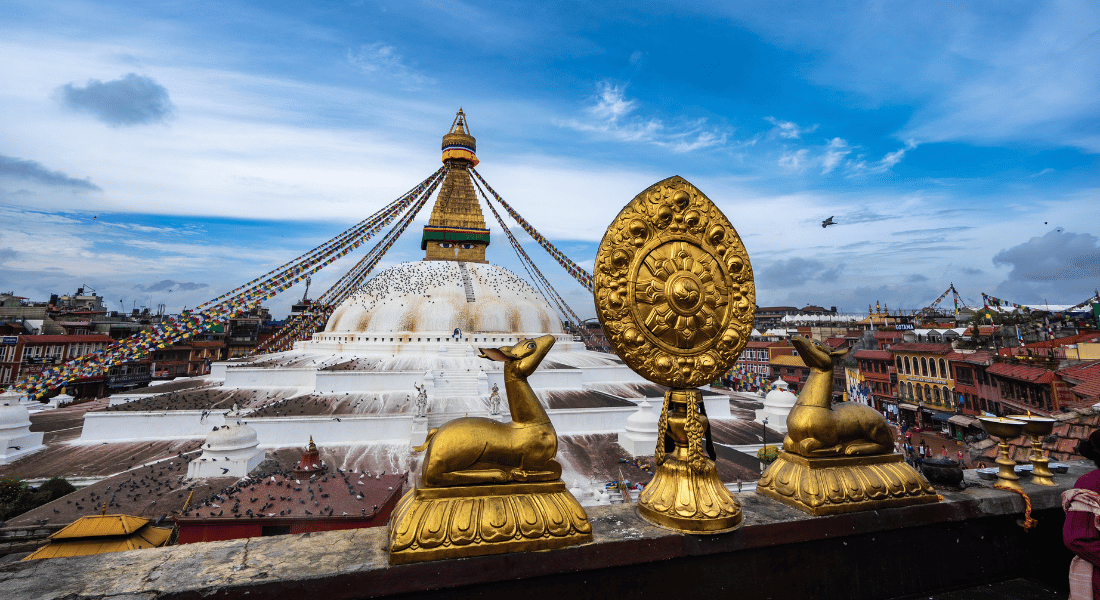
Spring (March to May)
This season offers mild temperatures and clear skies, making it ideal for sightseeing and outdoor activities. The weather is warm but not excessively hot, making it comfortable for exploring cities like Kathmandu, Bhaktapur, and Pokhara, as well as visiting religious landmarks such as Lumbini and Janakpur. Spring is also a good time to witness festivals such as Holi and Bisket Jatra, which add vibrancy to the cultural experience in Nepal.
Monsoon (June to August)
Monsoon season in Nepal invites continuous rainfall. In cities like Kathmandu and Pokhara, the weather remains warm but humid. It's a quieter time for tourists, making it possible to explore cultural sites with fewer crowds but due to continuous rainfall it might be difficult to participate in such activities. Summer is also a time when religious festivals such as Janai Purnima and Teej are celebrated, providing insight into Nepali culture and traditions. However, If you're planning to visit natural destinations such as Ghadruk and nagarkot the weather might not be at its best for enjoying the views.
Autumn (September to November)
Autumn is considered the best time to visit Nepal overall. The weather is cool and dry with clear skies, offering excellent visibility of the Himalayas and other natural landscapes. The season is also perfect if you want to visit mountains and natural areas such as Ghandruk, Nagarkot. However, it's also great for touring cultural sites and historical landmarks. Autumn in Nepal is also the festival season, with major celebrations such as Dashain and Tihar, providing opportunities to experience local traditions and festivities.
Winter (December to February)
Winter in Nepal is dry and cold, especially in higher altitudes where temperatures can drop below freezing. The skies are generally clear during this season, offering excellent visibility of the snow-capped Himalayas and making it a good time for mountain views and photography. Cities like Kathmandu and Pokhara are quieter and less crowded, allowing for a more relaxed exploration of cultural and historical sites.
Each season in Nepal offers its own unique charm and experiences, catering to different interests and preferences of travellers. However, The best time to visit Nepal from India is typically during the spring (March to May) and autumn (September to November) seasons, when the weather is pleasant, less risky and outdoor activities are at their best. However, the choice ultimately depends on your preferences and the specific activities you plan to engage in while visiting Nepal.
Learn More: Best time to visit Nepal from India
Recommended Tour Package
According to your travel style, preferences and various other factors, the itinerary for your visit to Nepal might differ. Mentioned below are some recommended itineraries/packages to visit Nepal according to your travel preferences:
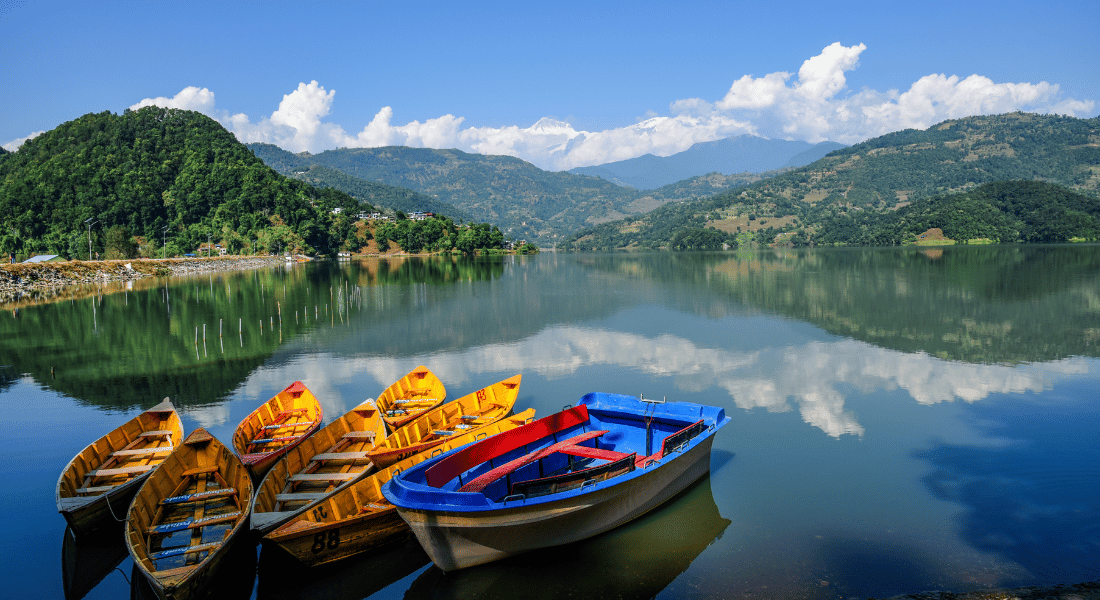
Nepal Religious Tour Package
Our Nepal Religious Tour Package opens the sacred doors for you to get the same experience. It is designed to offer you an opportunity to witness the perfect harmony of different religions here in Nepal. It covers the major pilgrimage landmarks in Kathmandu and Pokhara. Besides that, incredible pilgrimage areas such as Pashupatinath, Muktinath, Lumbini, and Janakpur are included in this package.
Outline Itinerary:
|
DAY 01: Kathmandu Arrival. |
|
DAY 02: Kathmandu Sightseeing. |
|
DAY 03: Fly to Lumbini, Lumbini Sightseeing. |
|
DAY 04: Fly to Pokhara, Pokhara Sightseeing. |
|
DAY 05: Fly to Jomsom, Drive to Muktinath. |
|
DAY 06: Fly to Kathmandu, Bhaktapur Sightseeing. |
|
DAY 07: Fly to Janakpur, Back to Kathmandu. |
|
DAY 08: Transfer to Airport. |
Learn More: Nepal Religious Tour Package
6 Days Nepal Tour Package by Flight
Our 6 days Nepal Tour Package by Flight is a convenient and time-efficient trip plan ideal for a family, group of friends, or couple. This trip is easily accessible, as the flight options can significantly reduce the time spent on long distance drives, allowing you to maximise your time exploring the wonders of Nepal. This 6 days plan of Nepal tour by flight covers two of the most prominent places in Nepal, such as Kathmandu and the Pokhara Valley.
Outline Itinerary:
|
DAY 01: Kathmandu Arrival. |
|
DAY 02: Kathmandu Sightseeing. |
|
DAY 3: Fly to Pokhara, Pokhara Sightseeing. |
|
DAY 04: Sarangkot Sunrise, Pokhara Leisure Day. |
|
DAY 05: Fly to Kathmandu, Bhaktapur Sightseeing. |
|
DAY 06: Transfer to Airport. |
Learn More: 6 Days Nepal Tour Package by Flight
Nepal Family Tour Package
Our Nepal family Tour Package is designed to provide opportunities for families to connect and bond in a unique and unforgettable way here in Nepal. It is a hassle-free trip where you can enjoy it together without worrying about other logistics such as transport or accommodation. This 8 days tour covers the three major tourist destinations in Nepal, making it a comprehensive tour package perfect for a family. The three major destinations are; Kathmandu, Pokhara and Chitwan.
Outline Itinerary:
|
DAY 01: Kathmandu Arrival. |
|
DAY 02: Kathmandu Sightseeing. |
|
DAY 03: Drive to Pokhara. |
|
DAY 04: Sarangkot Sunrise, Pokhara Sightseeing. |
|
DAY 05: Drive to Chitwan. |
|
DAY 06: Jungle Safari Activities. |
|
DAY 07: Drive to Kathmandu. |
|
DAY 08: Transfer to Airport. |
Learn More: Nepal Family Tour Package
Travel Tips from India
Nepal, with its majestic Himalayan landscapes, rich cultural heritage, and warm hospitality, is a captivating destination for travellers from India. Despite your different preferences and perspectives, here are some essential travel tips to make the most of your journey:
Visa and Documents
Indian citizens typically don't need a visa to enter Nepal. However, some valid documents need to be provided for the entry. For Adults, the documents include valid Indian Passport/voter id issued by Election Commission of India.
For Child (Below 18 years old), either a Valid Indian Passport, Birth Certificate issued by Government Authority, School ID or a letter from the school as a supportive document for Birth Certificate is required to visit Nepal.
Currency
Nepalese Rupee (NPR) is the official currency. Indian Rupees are widely accepted in bigger cities, but carry Nepali currency for transactions within the country. You can exchange your currency directly through a bank, travel agency or currency exchange centres.
Clothing
Nepal’s climate varies according to the season of travel and the variance of altitude. For spring and autumn, pack layers including lightweight clothing for warm days and a jacket for cooler evenings. Monsoon requires lightweight, breathable clothing and rain gear due to monsoon rains. Winter demands warm layers, a waterproof jacket, and insulated footwear for cold temperatures. Modest attire is advised for religious sites, and comfortable, functional clothing is essential for trekking and sightseeing.
Learn More: Travel Information for Indians Visiting Nepal
Conclusion
This blog above served as a comprehensive guide to the top five must-visit destinations in Nepal, offering readers an insightful exploration of what makes this country a remarkable travel destination. It meticulously details the diverse attractions that Nepal has to offer, from the vibrant cultural tapestry of Kathmandu and the serene beauty of Pokhara to the religious significance of Jankpur, the wildlife adventures in Chitwan, and the breathtaking environment of the Annapurna region. Each section is designed to provide readers with practical information, personal insights, and vivid descriptions, making it easier for them to plan an enriching and memorable journey.
Exploring Nepal is more than just visiting landmarks; it’s about immersing yourself in the heart and soul of a country that embraces its history, spirituality, and natural beauty. The warm hospitality of the Nepalese people, combined with the country’s stunning landscapes and vibrant traditions, creates a travel experience that is both enriching and transformative. By highlighting these key locations, the readers are not only provided with a roadmap to explore Nepal’s top destinations but also a glimpse into the experiences that make each place special.
Overall, this blog serves as a vital guide for anyone planning a visit to Nepal, offering an in-depth look at the country's most remarkable destinations. By blending practical travel tips with vivid descriptions and personal insights, it equips readers with everything they need to navigate Nepal's diverse attractions.



